| Article ID | Journal | Published Year | Pages | File Type |
|---|---|---|---|---|
| 2808284 | Neuropeptides | 2010 | 7 Pages |
Glucagon-like peptide-1 (7-36)-amide (GLP-1) is a gut peptide, which exerts significant effects on glucose homeostasis. GLP-1 and GLP-1 receptors are also widely distributed in the central nervous system. In the present study, we aimed to investigate the effects of intracerebroventricularly (i.c.v.)-injected GLP-1 on pilocarpine-induced seizures, anxiety and locomotor and exploratory activity in rat. Rats were pretreated with GLP-1 (1–1000 ng/5 μl; i.c.v.) or saline (5 μl; i.c.v.) 30 min before seizure induction by pilocarpine (2.4 mg/5 μl; i.c.v.) and with GLP-1 (1, 10, 100 ng/5 μl; i.c.v.) or saline (5 μl; i.c.v.) 30 min before the open field test or the elevated plus maze test. GLP-1 did not produce any protective effect against pilocarpine-induced seizures and did not also produce statistically significant differences in the number of squares visited (measure of locomotor activity) or number of rearings (measure of exploratory behaviour), compared to the saline-treated rats in the open field test. On the other hand, GLP-1 (1 ng and 10 ng; i.c.v.) induced an anxiogenic effect, indicated by a decrease in the time spent in open arms, an increase in the time spent in closed arms, and a decrease in the anxiety scores in the elevated plus maze test. Pretreatment with an arginine vasopressin (AVP) V1 receptor antagonist (125 ng/5 μl; i.c.v.) and L-NAME (100 μg/5 μl and 200 μg/5 μl) significantly abolished the anxiogenic effect of GLP-1 (1 ng/5 μl; i.c.v.). These results suggest that, centrally-injected GLP-1 produces anxiogenic effects via NO pathway and AVP V1 receptors, but does not have any effects on pilocarpine-induced seizures or locomotor and exploratory activity in the open field test.
